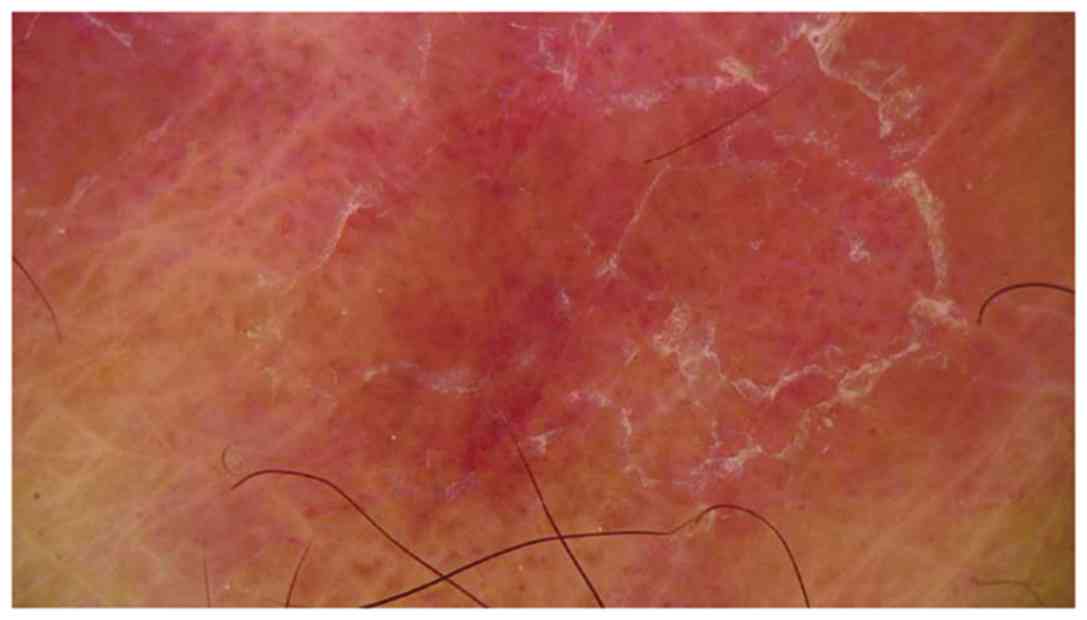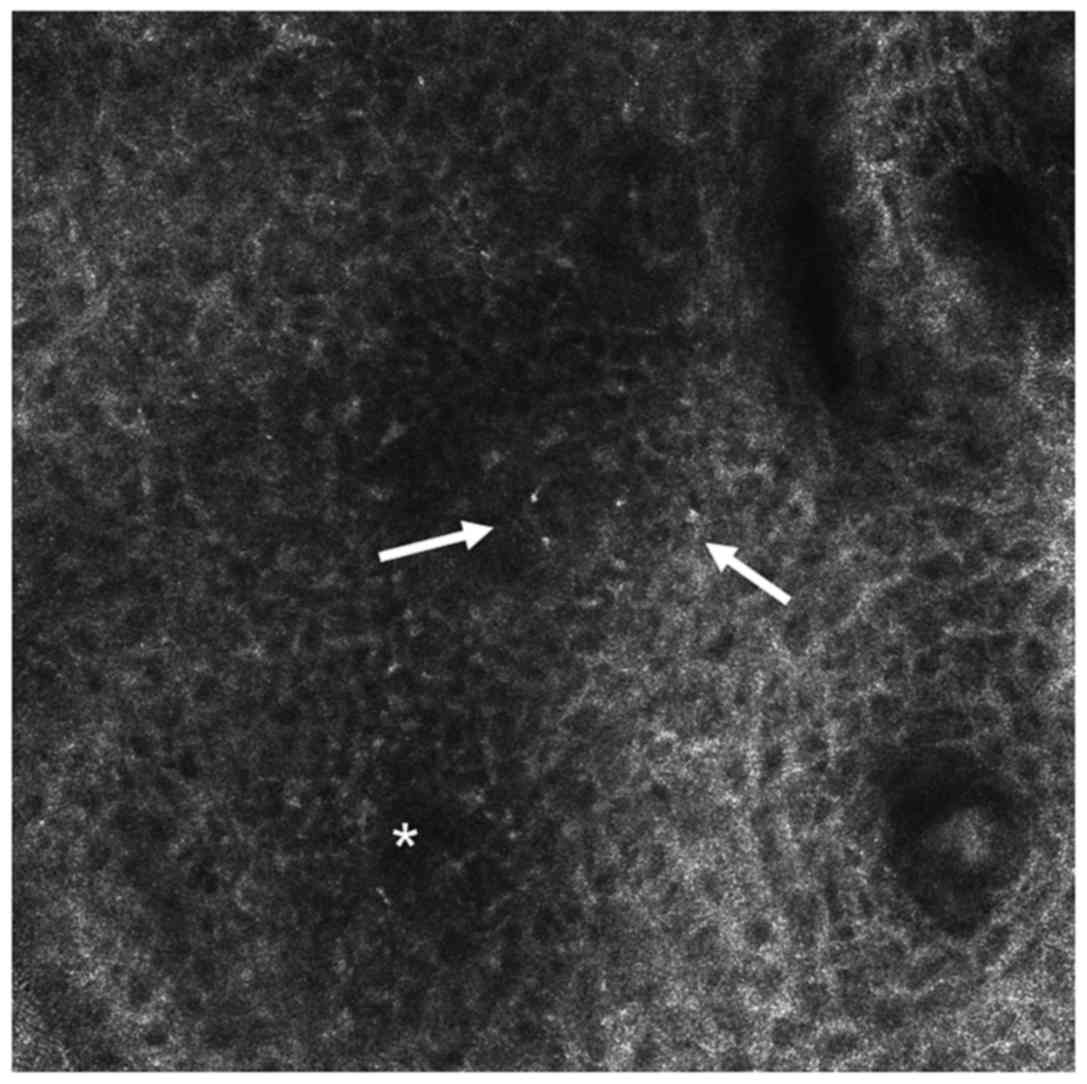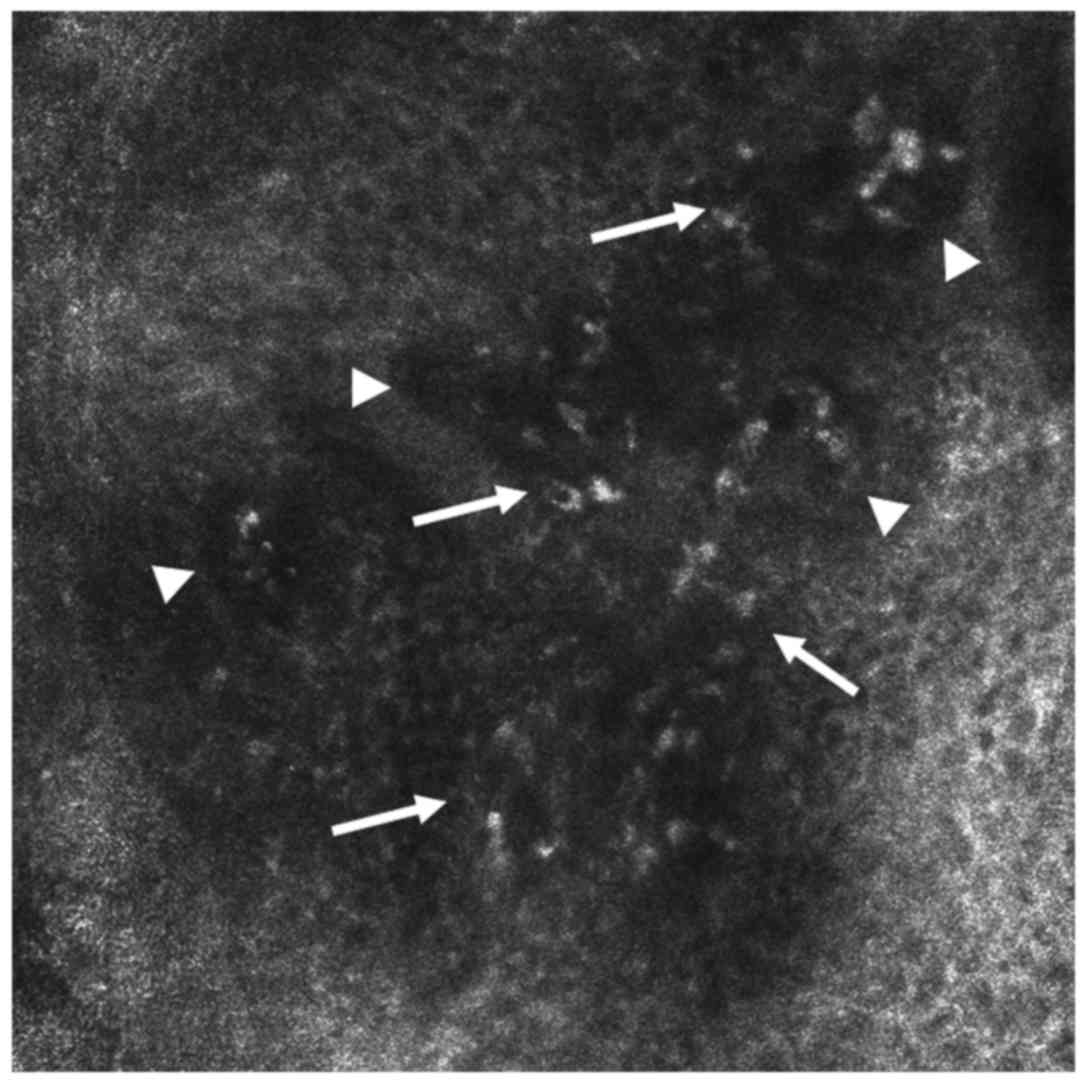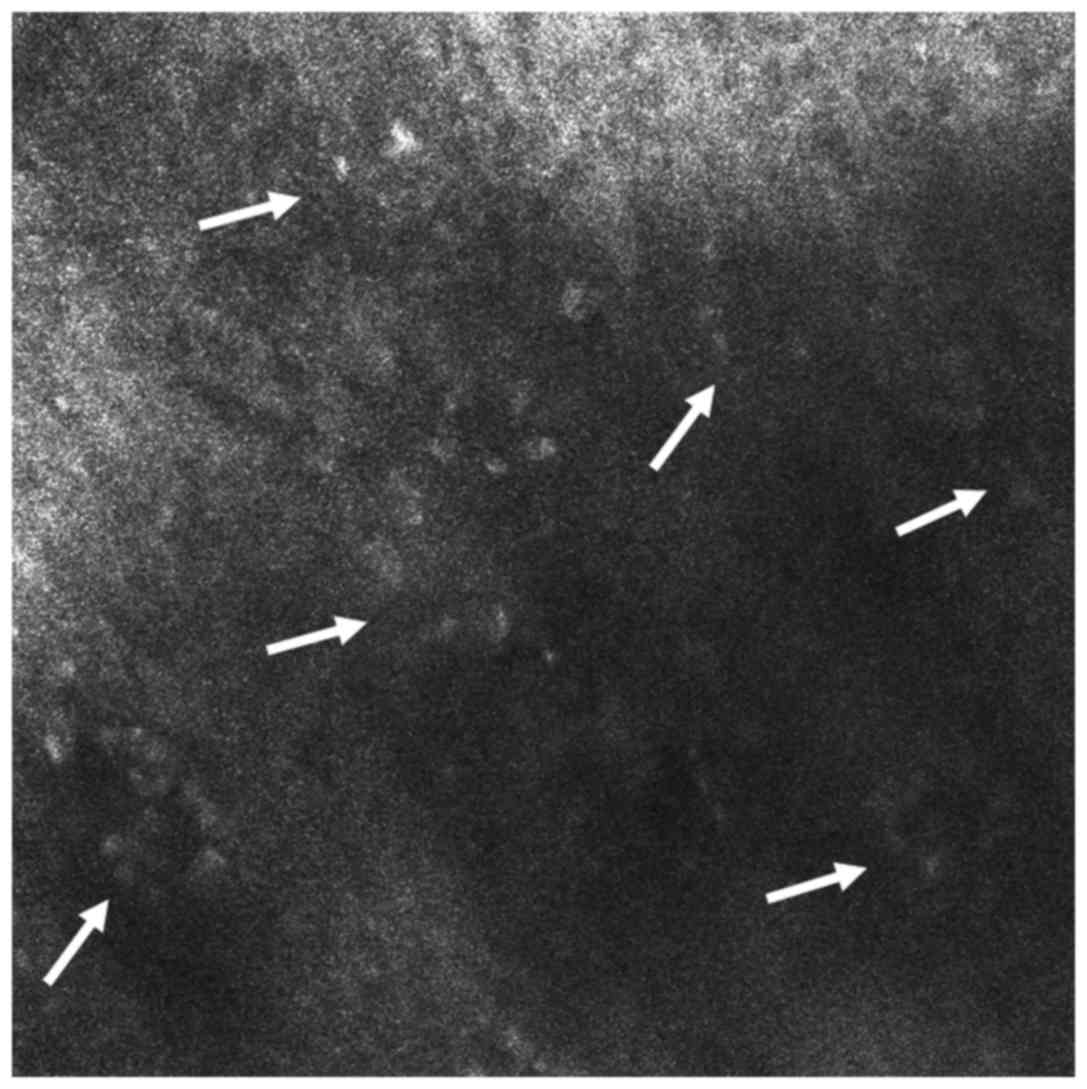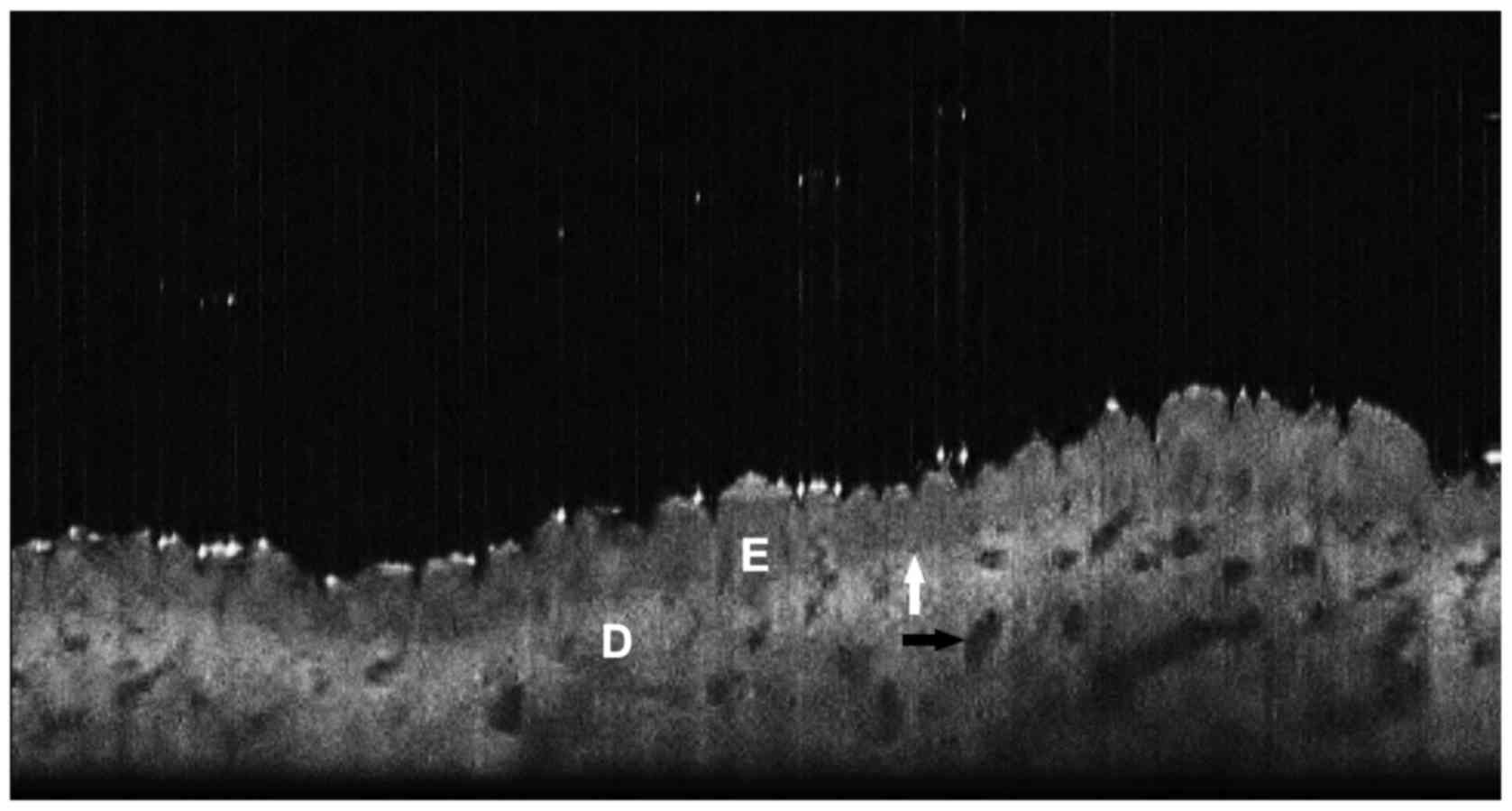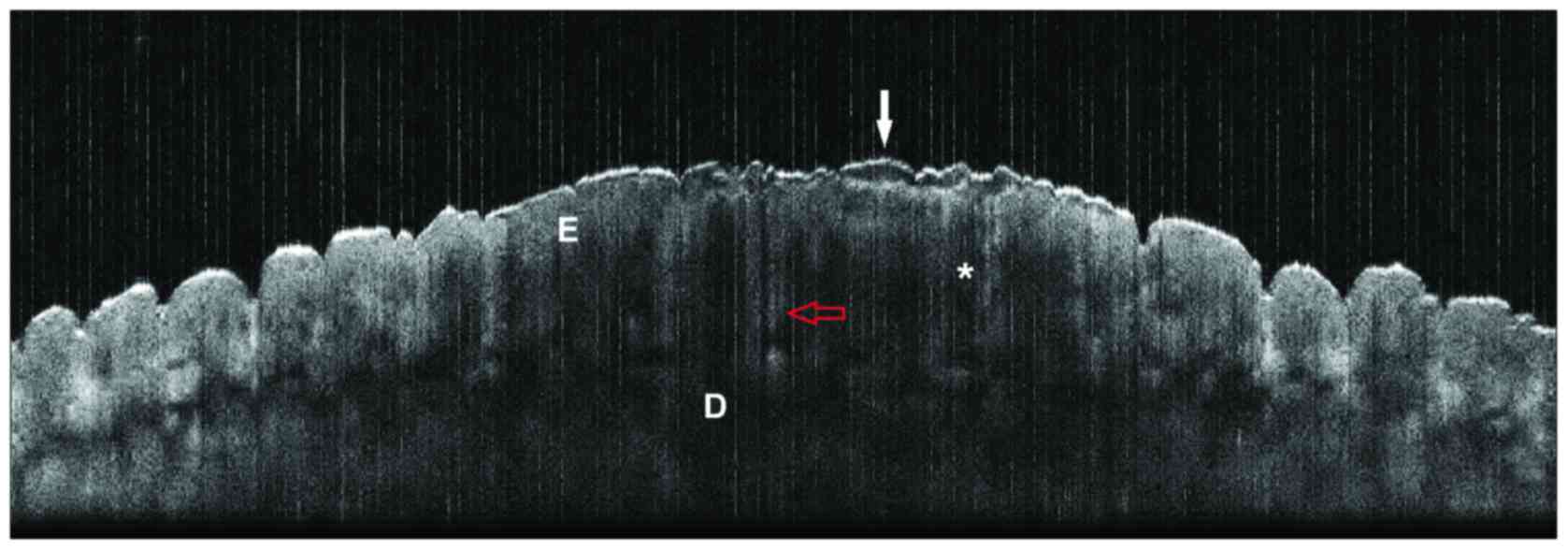|
1
|
Le Cleach L and Chosidow O: Clinical
practice. Lichen planus. N Engl J Med. 366:723–732. 2012.
View Article : Google Scholar : PubMed/NCBI
|
|
2
|
Gorouhi F, Davari P and Fazel N: Cutaneous
and mucosal lichen planus: A comprehensive review of clinical
subtypes, risk factors, diagnosis, and prognosis.
ScientificWorldJournal. 2014:7428262014. View Article : Google Scholar : PubMed/NCBI
|
|
3
|
Fazel N: Cutaneous lichen planus: A
systematic review of treatments. J Dermatolog Treat. 26:280–283.
2015. View Article : Google Scholar : PubMed/NCBI
|
|
4
|
Arora SK, Chhabra S, Saikia UN, Dogra S
and Minz RW: Lichen planus: A clinical and immuno-histological
analysis. Indian J Dermatol. 59:257–261. 2014. View Article : Google Scholar : PubMed/NCBI
|
|
5
|
Friedman P, Sabban EC, Marcucci C, Peralta
R and Cabo H: Dermoscopic findings in different clinical variants
of lichen planus. Is dermoscopy useful? Dermatol Pract Concept.
5:51–55. 2015.PubMed/NCBI
|
|
6
|
Eisen D: The clinical features, malignant
potential, and systemic associations of oral lichen planus: A study
of 723 patients. J Am Acad Dermatol. 46:207–214. 2002. View Article : Google Scholar : PubMed/NCBI
|
|
7
|
Carbone M, Arduino PG, Carrozzo M,
Gandolfo S, Argiolas MR, Bertolusso G, Conrotto D, Pentenero M and
Broccoletti R: Course of oral lichen planus: A retrospective study
of 808 northern Italian patients. Oral Dis. 15:235–243. 2009.
View Article : Google Scholar : PubMed/NCBI
|
|
8
|
Bermejo-Fenoll A, Sánchez-Siles M,
López-Jornet P, Camacho-Alonso F and Salazar-Sánchez N: A
retrospective clinicopathological study of 550 patients with oral
lichen planus in south-eastern Spain. J Oral Pathol Med.
39:491–496. 2010. View Article : Google Scholar : PubMed/NCBI
|
|
9
|
Irvine C, Irvine F and Champion RH:
Long-term follow-up of lichen planus. Acta Derm Venereol.
71:242–244. 1991.PubMed/NCBI
|
|
10
|
Sugerman PB, Savage NW, Walsh LJ, Zhao ZZ,
Zhou XJ, Khan A, Seymour GJ and Bigby M: The pathogenesis of oral
lichen planus. Crit Rev Oral Biol Med. 13:350–365. 2002. View Article : Google Scholar : PubMed/NCBI
|
|
11
|
Epidemiological evidence of the
association between lichen planus and two immune-related diseases.
Alopecia areata and ulcerative colitis. Gruppo Italiano Studi
Epidemiologici in Dermatologia. Arch Dermatol. 127:688–691. 1991.
View Article : Google Scholar : PubMed/NCBI
|
|
12
|
Lodi G, Pellicano R and Carrozzo M:
Hepatitis C virus infection and lichen planus: A systematic review
with meta-analysis. Oral Dis. 16:601–612. 2010. View Article : Google Scholar : PubMed/NCBI
|
|
13
|
Shengyuan L, Songpo Y, Wen W, Wenjing T,
Haitao Z, Binyou W and Hepatitis C: Hepatitis C virus and lichen
planus: A reciprocal association determined by a meta-analysis.
Arch Dermatol. 145:1040–1047. 2009. View Article : Google Scholar : PubMed/NCBI
|
|
14
|
Girardi C, Luz C, Cherubini K, de
Figueiredo MA, Nunes ML and Salum FG: Salivary cortisol and
dehydroepiandrosterone (DHEA) levels, psychological factors in
patients with oral lichen planus. Arch Oral Biol. 56:864–868. 2011.
View Article : Google Scholar : PubMed/NCBI
|
|
15
|
Constantin C, Corina G, Ana C, Adriana D
and Daniel B: The role of stress in skin diseases. Intern Med.
8:73–84. 2011.
|
|
16
|
Iijima W, Ohtani H, Nakayama T, Sugawara
Y, Sato E, Nagura H, Yoshie O and Sasano T: Infiltrating
CD8+ T cells in oral lichen planus predominantly express
CCR5 and CXCR3 and carry respective chemokine ligands RANTES/CCL5
and IP-10/CXCL10 in their cytolytic granules: A potential
self-recruiting mechanism. Am J Pathol. 163:261–268. 2003.
View Article : Google Scholar : PubMed/NCBI
|
|
17
|
Sharma A, Białynicki-Birula R, Schwartz RA
and Janniger CK: Lichen planus: An update and review. Cutis.
90:17–23. 2012.PubMed/NCBI
|
|
18
|
Moscarella E, González S, Agozzino M,
Sánchez-Mateos JL, Panetta C, Contaldo M and Ardigò M: Pilot study
on reflectance confocal microscopy imaging of lichen planus: A
real-time, non-invasive aid for clinical diagnosis. J Eur Acad
Dermatol Venereol. 26:1258–1265. 2012. View Article : Google Scholar : PubMed/NCBI
|
|
19
|
Agozzino M, Gonzalez S and Ardigò M:
Reflectance confocal microscopy for inflammatory skin diseases.
Actas Dermosifiliogr. 107:631–639. 2016. View Article : Google Scholar : PubMed/NCBI
|
|
20
|
Batani A, Brănișteanu DE, Ilie MA, Boda D,
Ianosi S, Ianosi G and Caruntu C: Assessment of dermal papillary
and microvascular parameters in psoriasis vulgaris using in
vivo reflectance confocal microscopy. Exp Ther Med.
15:1241–1246. 2018.PubMed/NCBI
|
|
21
|
Manfredini M, Greco M, Farnetani F, Ciardo
S, De Carvalho N, Mandel VD, Starace M and Pellacani G: Acne:
Morphologic and vascular study of lesions and surrounding skin by
means of optical coherence tomography. J Eur Acad Dermatol
Venereol. 31:1541–1546. 2017. View Article : Google Scholar : PubMed/NCBI
|
|
22
|
Ianosi S, Neagoe D, Calbureanu M and
Ianosi G: Investigator-blind, placebo-controlled, randomized
comparative study on combined vacuum and intense pulsed light
versus intense pulsed light devices in both comedonal and
papulopustular acne. J Cosmet Laser Ther. 15:248–254. 2013.
View Article : Google Scholar : PubMed/NCBI
|
|
23
|
Caruntu C, Boda D, Dumitrascu G,
Constantin C and Neagu M: Proteomics focusing on immune markers in
psoriatic arthritis. Biomarkers Med. 9:513–528. 2015. View Article : Google Scholar
|
|
24
|
Tan C, Min ZS, Xue Y and Zhu WY: Spectrum
of dermoscopic patterns in lichen planus: A case series from China.
J Cutan Med Surg. 18:28–32. 2014. View Article : Google Scholar : PubMed/NCBI
|
|
25
|
Vázquez-López F, Gómez-Díez S, Sánchez J
and Pérez-Oliva N: Dermoscopy of active lichen planus. Arch
Dermatol. 143:10922007. View Article : Google Scholar : PubMed/NCBI
|
|
26
|
Zalaudek I and Argenziano G: Dermoscopy
subpatterns of inflammatory skin disorders. Arch Dermatol.
142:8082006. View Article : Google Scholar : PubMed/NCBI
|
|
27
|
Lallas A, Kyrgidis A, Tzellos TG, Apalla
Z, Karakyriou E, Karatolias A, Lefaki I, Sotiriou E, Ioannides D,
Argenziano G, et al: Accuracy of dermoscopic criteria for the
diagnosis of psoriasis, dermatitis, lichen planus and pityriasis
rosea. Br J Dermatol. 166:1198–1205. 2012. View Article : Google Scholar : PubMed/NCBI
|
|
28
|
Wickham L: Sur un signe pathognomonique du
lichen de Wilson (lichen plan) Stries et ponctuations grisatres.
Ann Dermatol Syph. 6:517–520. 1895.
|
|
29
|
Vázquez-López F, Manjón-Haces JA,
Maldonado-Seral C, Raya-Aguado C, Pérez-Oliva N and Marghoob AA:
Dermoscopic features of plaque psoriasis and lichen planus: New
observations. Dermatology. 207:151–156. 2003. View Article : Google Scholar : PubMed/NCBI
|
|
30
|
Güngör Ş, Topal IO and Göncü EK:
Dermoscopic patterns in active and regressive lichen planus and
lichen planus variants: A morphological study. Dermatol Pract
Concept. 5:45–53. 2015.
|
|
31
|
Vazquez-Lopez F, Palacios-Garcia L,
Gomez-Diez S and Argenziano G: Dermoscopy for discriminating
between lichenoid sarcoidosis and lichen planus. Arch Dermatol.
147:1130. 2011. View Article : Google Scholar : PubMed/NCBI
|
|
32
|
Güngör Ş, Topal IO, Erdogan Ş and Özcan D:
Classical lichen planus and lichen planus pigmentosus inversus
overlap with dermoscopic features. Our Dermatol Online. 5:42–44.
2014. View Article : Google Scholar
|
|
33
|
Vázquez-López F, Vidal AM and Zalaudek I:
Dermoscopic subpatterns of ashy dermatosis related to lichen
planus. Arch Dermatol. 146:1102010. View Article : Google Scholar : PubMed/NCBI
|
|
34
|
Vázquez-López F, Maldonado-Seral C,
López-Escobar M and Pérez-Oliva N: Dermoscopy of pigmented lichen
planus lesions. Clin Exp Dermatol. 28:554–555. 2003. View Article : Google Scholar : PubMed/NCBI
|
|
35
|
Summerly R and Jones EW: The
microarchitecture of Wickham's striae. Trans St Johns Hosp Dermatol
Soc. 50:157–161. 1964.PubMed/NCBI
|
|
36
|
Ryan TJ: Lichen planus, Whickham's striae
and blood vessels. Br J Dermatol. 85:497–498. 1971. View Article : Google Scholar : PubMed/NCBI
|
|
37
|
Liebman TN, Rabinovitz HS, Dusza SW and
Marghoob AA: White shiny structures: dermoscopic features revealed
under polarized light. J Eur Acad Dermatol Venereol. 26:1493–1497.
2012.PubMed/NCBI
|
|
38
|
Vázquez-López F, Alvarez-Cuesta C,
Hidalgo-García Y and Pérez-Oliva N: The handheld dermatoscope
improves the recognition of Wickham striae and capillaries in
Lichen planus lesions. Arch Dermatol. 137:1376. 2001.
|
|
39
|
Soyer HP, Argenziano G, Chimenti S and
Ruocco V: Dermoscopy of pigmented skin lesions. Eur J Dermatol.
11:270–276. 2001.PubMed/NCBI
|
|
40
|
Diaconeasa A, Boda D, Neagu M, Constantin
C, Căruntu C, Vlădău L and Guţu D: The role of confocal microscopy
in the dermato-oncology practice. J Med Life. 4:63–74.
2011.PubMed/NCBI
|
|
41
|
Ghita MA, Caruntu C, Rosca AE, Kaleshi H,
Caruntu A, Moraru L, Docea AO, Zurac S, Boda D, Neagu M, et al:
Reflectance confocal microscopy and dermoscopy for in vivo,
non-invasive skin imaging of superficial basal cell carcinoma.
Oncol Lett. 11:3019–3024. 2016. View Article : Google Scholar : PubMed/NCBI
|
|
42
|
Căruntu C, Boda D, Guţu DE and Căruntu A:
In vivo reflectance confocal microscopy of basal cell
carcinoma with cystic degeneration. Rom J Morphol Embryol.
55:1437–1441. 2014.PubMed/NCBI
|
|
43
|
Lupu M, Caruntu C, Solomon I, Popa A,
Lisievici C, Draghici C, Papagheorghe L, Voiculescu VM and
Giurcaneanu C: The use of in vivo reflectance confocal
microscopy and dermoscopy in the preoperative determination of
basal cell carcinoma histopathological subtypes. DermatoVenerol.
62:7–13. 2017.
|
|
44
|
Lupu M, Caruntu A, Caruntu C, Boda D,
Moraru L, Voiculescu V and Bastian A: Non-invasive imaging of
actinic cheilitis and squamous cell carcinoma of the lip. Mol Clin
Oncol. 8:640–646. 2018.PubMed/NCBI
|
|
45
|
Langley RGB, Rajadhyaksha M, Dwyer PJ,
Sober AJ, Flotte TJ and Anderson RR: Confocal scanning laser
microscopy of benign and malignant melanocytic skin lesions in
vivo. J Am Acad Dermatol. 45:365–376. 2001. View Article : Google Scholar : PubMed/NCBI
|
|
46
|
González S: Confocal reflectance
microscopy in dermatology: Promise and reality of non-invasive
diagnosis and monitoring. Actas Dermosifiliogr. 100 Suppl 2:59–69.
2009. View Article : Google Scholar : PubMed/NCBI
|
|
47
|
Guida S, Longo C, Casari A, Ciardo S,
Manfredini M, Reggiani C, Pellacani G and Farnetani F: Update on
the use of confocal microscopy in melanoma and non-melanoma skin
cancer. G Ital Dermatol Venereol. 150:547–563. 2015.PubMed/NCBI
|
|
48
|
Alessi SS, Nico MMS, Fernandes JD and
Lourenço SV: Reflectance confocal microscopy as a new tool in the
in vivo evaluation of desquamative gingivitis: Patterns in
mucous membrane pemphigoid, pemphigus vulgaris and oral lichen
planus. Br J Dermatol. 168:257–264. 2013. View Article : Google Scholar : PubMed/NCBI
|
|
49
|
Farnetani F, Scope A, Braun RP, Gonzalez
S, Guitera P, Malvehy J, Manfredini M, Marghoob AA, Moscarella E,
Oliviero M, et al: Skin cancer diagnosis with reflectance confocal
microscopy: Reproducibility of feature recognition and accuracy of
diagnosis. JAMA Dermatol. 151:1075–1080. 2015. View Article : Google Scholar : PubMed/NCBI
|
|
50
|
Căruntu C, Boda D, Căruntu A, Rotaru M,
Baderca F and Zurac S: In vivo imaging techniques for
psoriatic lesions. Rom J Morphol Embryol. 55:1191–1196.
2014.PubMed/NCBI
|
|
51
|
Agozzino M, Berardesca E, Donadio C,
Franceschini C, de Felice CM, Cavallotti C, Sperduti I and Ardigò
M: Reflectance confocal microscopy features of seborrheic
dermatitis for plaque psoriasis differentiation. Dermatology.
229:215–221. 2014. View Article : Google Scholar : PubMed/NCBI
|
|
52
|
Ardigo M, Cota C, Berardesca E and
González S: Concordance between in vivo reflectance confocal
microscopy and histology in the evaluation of plaque psoriasis. J
Eur Acad Dermatol Venereol. 23:660–667. 2009. View Article : Google Scholar : PubMed/NCBI
|
|
53
|
González S, González E, White WM,
Rajadhyaksha M and Anderson RR: Allergic contact dermatitis:
Correlation of in vivo confocal imaging to routine
histology. J Am Acad Dermatol. 40:708–713. 1999. View Article : Google Scholar : PubMed/NCBI
|
|
54
|
Białek-Galas K, Wielowieyska-Szybińska D,
Dyduch G and Wojas-Pelc A: The use of reflectance confocal
microscopy in selected inflammatory skin diseases. Pol J Pathol.
66:103–108. 2015. View Article : Google Scholar : PubMed/NCBI
|
|
55
|
Başaran YK, Gürel MS, Erdemir AT, Turan E,
Yurt N and Bağci IS: Evaluation of the response to treatment of
psoriasis vulgaris with reflectance confocal microscopy. Skin Res
Technol. 21:18–24. 2015. View Article : Google Scholar : PubMed/NCBI
|
|
56
|
Căruntu C and Boda D: Evaluation through
in vivo reflectance confocal microscopy of the cutaneous
neurogenic inflammatory reaction induced by capsaicin in human
subjects. J Biomed Opt. 17:0850032012. View Article : Google Scholar : PubMed/NCBI
|
|
57
|
Ghiţă MA, Căruntu C, Rosca AE, Căruntu A,
Moraru L, Constantin C, Neagu M and Boda D: Real-time investigation
of skin blood flow changes induced by topical capsaicin. Acta
Dermatovenerol Croat. 25:223–227. 2017.PubMed/NCBI
|
|
58
|
Hoogedoorn L, Peppelman M, van de Kerkhof
PC, van Erp PE and Gerritsen MJ: The value of in vivo
reflectance confocal microscopy in the diagnosis and monitoring of
inflammatory and infectious skin diseases: A systematic review. Br
J Dermatol. 172:1222–1248. 2015. View Article : Google Scholar : PubMed/NCBI
|
|
59
|
Rajadhyaksha M, González S, Zavislan JM,
Anderson RR and Webb RH: In vivo confocal scanning laser
microscopy of human skin II: Advances in instrumentation and
comparison with histology. J Invest Dermatol. 113:293–303. 1999.
View Article : Google Scholar : PubMed/NCBI
|
|
60
|
Hofmann-Wellenhof R, Pellacani G, Malvehy
J and Soyer HP: Interface dermatitis. Reflectance Confocal
Microscopy for Skin Diseases. Springer; Berlin: pp. 392–400.
2012
|
|
61
|
Bağcı IS, Gürel MS, Aksu AEK, Erdemir AT,
Yüksel Eİ and Başaran YK: Reflectance confocal microscopic
evaluation of nonmelanocytic lip lesions. Lasers Med Sci.
32:1497–1506. 2017. View Article : Google Scholar : PubMed/NCBI
|
|
62
|
Longo C, Zalaudek I, Argenziano G and
Pellacani G: New directions in dermatopathology: In vivo
confocal microscopy in clinical practice. Dermatol Clin. 30799–814.
(viii)2012. View Article : Google Scholar : PubMed/NCBI
|
|
63
|
Contaldo M, Agozzino M, Moscarella E,
Esposito S, Serpico R and Ardigò M: In vivo characterization
of healthy oral mucosa by reflectance confocal microscopy: A
translational research for optical biopsy. Ultrastruct Pathol.
37:151–158. 2013. View Article : Google Scholar : PubMed/NCBI
|
|
64
|
Ardigò M, Maliszewski I, Cota C, Scope A,
Sacerdoti G, Gonzalez S and Berardesca E: Preliminary evaluation of
in vivo reflectance confocal microscopy features of discoid
lupus erythematosus. Br J Dermatol. 156:1196–1203. 2007. View Article : Google Scholar : PubMed/NCBI
|
|
65
|
Kelloff GJ, Sullivan DC, Baker H, Clarke
LP, Nordstrom R, Tatum JL, Dorfman GS, Jacobs P, Berg CD, Pomper
MG, et al: Workshop Program Committee: Workshop on imaging science
development for cancer prevention and preemption. Cancer Biomark.
3:1–33. 2007. View Article : Google Scholar : PubMed/NCBI
|
|
66
|
Calzavara-Pinton P, Longo C, Venturini M,
Sala R and Pellacani G: Reflectance confocal microscopy for in
vivo skin imaging. Photochem Photobiol. 84:1421–1430. 2008.
View Article : Google Scholar : PubMed/NCBI
|
|
67
|
Ardigo M, Donadio C, Franceschini C,
Catricalà C and Agozzino M: Interest of reflectance confocal
microscopy for inflammatory oral mucosal diseases. J Eur Acad
Dermatol Venereol. 29:1850–1853. 2015. View Article : Google Scholar : PubMed/NCBI
|
|
68
|
Baderca F, Lighezan R, Alexa A, Zăhoi D,
Raica M, Izvernariu D and Ardelean L: Atypical variant of lichen
planus mimicking normal skin histology. Rom J Morphol Embryol.
52:1355–1360. 2011.PubMed/NCBI
|
|
69
|
Serup J, Jemec GBE and Grove GL: Optical
coherence tomography in dermatology. Handbook of Non-Invasive
Methods and the Skin. 2nd. CRC Press; Boca Raton, FL: 2006
|
|
70
|
Gambichler T, Jaedicke V and Terras S:
Optical coherence tomography in dermatology: Technical and clinical
aspects. Arch Dermatol Res. 303:457–473. 2011. View Article : Google Scholar : PubMed/NCBI
|
|
71
|
Sattler E, Kästle R and Welzel J: Optical
coherence tomography in dermatology. J Biomed Opt. 18:0612242013.
View Article : Google Scholar : PubMed/NCBI
|
|
72
|
Gambichler T, Pljakic A and Schmitz L:
Recent advances in clinical application of optical coherence
tomography of human skin. Clin Cosmet Investig Dermatol. 8:345–354.
2015. View Article : Google Scholar : PubMed/NCBI
|
|
73
|
Jung S, Lademann J, Darvin ME, Richter C,
Pedersen CB, Richter H, Schanzer S, Kottner J, Blume-Peytavi U and
Røpke MA: In vivo characterization of structural changes
after topical application of glucocorticoids in healthy human skin.
J Biomed Opt. 22:760182017. View Article : Google Scholar : PubMed/NCBI
|
|
74
|
Levine A, Wang K and Markowitz O: Optical
coherence tomography in the diagnosis of skin cancer. Dermatol
Clin. 35:465–488. 2017. View Article : Google Scholar : PubMed/NCBI
|
|
75
|
Popescu I, Carstea E, Turcu G, Giurcaneanu
C and Forsea A: Multimodal optospectral investigation of
melanocytic skin lesions: A correlation study using optical
coherence tomography and dermoscopy. Rom Rep Phys. 66:672–682.
2014.
|
|
76
|
Mogensen M, Joergensen TM, Nürnberg BM,
Morsy HA, Thomsen JB, Thrane L and Jemec GB: Assessment of optical
coherence tomography imaging in the diagnosis of non-melanoma skin
cancer and benign lesions versus normal skin. Dermatol Surg.
35:965–972. 2009. View Article : Google Scholar : PubMed/NCBI
|
|
77
|
Boone MALM, Suppa M, Pellacani G, Marneffe
A, Miyamoto M, Alarcon I, Ruini C, Hofmann-Wellenhof R, Malvehy J,
Jemec GBE, et al: High-definition optical coherence tomography
algorithm for discrimination of basal cell carcinoma from clinical
BCC imitators and differentiation between common subtypes. J Eur
Acad Dermatol Venereol. 29:1771–1780. 2015. View Article : Google Scholar : PubMed/NCBI
|
|
78
|
Boone MALM, Suppa M, Marneffe A, Miyamoto
M, Jemec GBE and Del Marmol V: A new algorithm for the
discrimination of actinic keratosis from normal skin and squamous
cell carcinoma based on in vivo analysis of optical
properties by high-definition optical coherence tomography. J Eur
Acad Dermatol Venereol. 30:1714–1725. 2016. View Article : Google Scholar : PubMed/NCBI
|
|
79
|
Wang KX, Meekings A, Fluhr JW, McKenzie G,
Lee DA, Fisher J, Markowitz O and Siegel DM: Optical coherence
tomography-based optimization of mohs micrographic surgery of Basal
cell carcinoma: A pilot study. Dermatol Surg. 39:627–633. 2013.
View Article : Google Scholar : PubMed/NCBI
|
|
80
|
Olsen J, Themstrup L and Jemec GB: Optical
coherence tomography in dermatology. G Ital Dermatol Venereol.
150:603–615. 2015.PubMed/NCBI
|
|
81
|
Forsea A-M, Carstea EM, Ghervase L,
Giurcaneanu C and Pavelescu G: Clinical application of optical
coherence tomography for the imaging of non-melanocytic cutaneous
tumors: A pilot multi-modal study. J Med Life. 3:381–389.
2010.PubMed/NCBI
|
|
82
|
Boone M, Norrenberg S, Jemec G and Del
Marmol V: High-definition optical coherence tomography: adapted
algorithmic method for pattern analysis of inflammatory skin
diseases: a pilot study. Arch Dermatol Res. 305:283–297. 2013.
View Article : Google Scholar : PubMed/NCBI
|
|
83
|
Schmitz L, Gambichler T, Zerbinati N and
Dirschka T: Optical coherence tomography of palmoplantar lichen
planus and ultraviolet A1 laser treatment: A case report. J Dtsch
Dermatol Ges. 12:e9–e10. 2014.
|
|
84
|
Fomina IuV, Gladkova ND, Leont'ev VK,
Urutina MN, Gazhva SI, Snopova LB, Gelikonov VM and Kamenskiĭ VA:
Optical coherence tomography in the evaluation of the oral cavity
mucosa. Part II. Benign and malignant diseases. Stomatologiia
(Mosk). 83:25–32. 2004.(In Russian).
|
|
85
|
Hamdoon Z, Jerjes W, Al-Delayme R,
McKenzie G, Jay A and Hopper C: Structural validation of oral
mucosal tissue using optical coherence tomography. Head Neck Oncol.
4:292012. View Article : Google Scholar : PubMed/NCBI
|
|
86
|
Wilder-Smith P, Lee K, Guo S, Zhang J,
Osann K, Chen Z and Messadi D: In vivo diagnosis of oral
dysplasia and malignancy using optical coherence tomography:
Preliminary studies in 50 patients. Lasers Surg Med. 41:353–357.
2009. View Article : Google Scholar : PubMed/NCBI
|
|
87
|
Bhatia N, Lalla Y, Vu AN and Farah CS:
Advances in optical adjunctive AIDS for visualisation and detection
of oral malignant and potentially malignant lesions. Int J Dent.
2013:1940292013. View Article : Google Scholar : PubMed/NCBI
|
|
88
|
Adabi S, Turani Z, Fatemizadeh E, Clayton
A and Nasiriavanaki M: Optical coherence tomography technology and
quality improvement methods for optical coherence Tomography images
of skin: A short review. Biomed Eng Comput Biol.
8:11795972177134752017. View Article : Google Scholar : PubMed/NCBI
|
|
89
|
Alexander H and Miller DL: Determining
skin thickness with pulsed ultra sound. J Invest Dermatol.
72:17–19. 1979. View Article : Google Scholar : PubMed/NCBI
|
|
90
|
El Gammal S, El Gammal C, Kaspar K, Pieck
C, Altmeyer P, Vogt M and Ermert H: Sonography of the skin at 100
MHz enables in vivo visualization of stratum corneum and
viable epidermis in palmar skin and psoriatic plaques. J Invest
Dermatol. 113:821–829. 1999. View Article : Google Scholar : PubMed/NCBI
|
|
91
|
El Gammal S, Auer T, Hoffmann K, Altmeyer
P, Passmann C and Ermert H: Grundlagen, anwendungsgebiete und
grenzen des hochfrequenten (20–50 MHz) ultraschalls in der
dermatologie. Zbl Haut. 162:817–838. 1993.(In German).
|
|
92
|
El-Gammal S, Auer T, Hoffmann K, Matthes U
and Altmeyer P: Möglichkeiten und Grenzen der hochauflösenden (20
und 50 MHz) Sonographie in der Dermatologie. Aktuelle Derm.
18:197–208. 1992.(In German).
|
|
93
|
Seidenari S and Di Nardo A: B scanning
evaluation of irritant reactions with binary transformation and
image analysis. Acta Derm Venereol Suppl (Stockh). 175:9–13.
1992.PubMed/NCBI
|
|
94
|
Seidenari S: High-frequency sonography
combined with image analysis: A noninvasive objective method for
skin evaluation and description. Clin Dermatol. 13:349–359. 1995.
View Article : Google Scholar : PubMed/NCBI
|
|
95
|
Jayanthi JL, Nisha GU, Manju S, Philip EK,
Jeemon P, Baiju KV, Beena VT and Subhash N: Diffuse reflectance
spectroscopy: Diagnostic accuracy of a non-invasive screening
technique for early detection of malignant changes in the oral
cavity. BMJ Open. 1:e0000712011. View Article : Google Scholar : PubMed/NCBI
|
|
96
|
Messadi DV, Younai FS, Liu HH, Guo G and
Wang CY: The clinical effectiveness of reflectance optical
spectroscopy for the in vivo diagnosis of oral lesions. Int
J Oral Sci. 6:162–167. 2014. View Article : Google Scholar : PubMed/NCBI
|
|
97
|
Gupta S and Jawanda MK: Oral Lichen
Planus: An update on etiology, pathogenesis, clinical presentation,
diagnosis and management. Indian J Dermatol. 60:222–229. 2015.
View Article : Google Scholar : PubMed/NCBI
|















